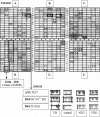Vasospastic individuals demonstrate significant similarity to glaucoma patients as revealed by gene expression profiling in circulating leukocytes
- PMID: 19936302
- PMCID: PMC2779057
Vasospastic individuals demonstrate significant similarity to glaucoma patients as revealed by gene expression profiling in circulating leukocytes
Abstract
Purpose: There is growing evidence that vasospatic individuals could be predisposed to develop glaucoma. Vasospastic deregulation is ensuing in activation of circulating leukocytes. In previous studies using "gene-hunting" strategies, we demonstrated stable alterations in gene expression profiles of circulating leukocytes isolated from glaucoma patients with vascular deregulation when compared to healthy individuals with no history of glaucomatous damage. The goal of this study was to look for possible similarities in gene expression profiles of circulating leukocytes in vasospastic individuals and glaucoma patients.
Methods: Normal-tension (NTG) and high-tension (HTG) glaucoma patients as well as individuals with vascular deregulation (VD) and healthy controls were recruited for the gene expression analysis. The methodology of comparative Expression Array analysis followed by highly sensitive quantitative real-time PCR has been used.
Results: Compared to the control group the expression of 146, 68, and 60 genes was found to be altered in NTG, HTG, and VD groups respectively. Thirty-four genes demonstrated similar expressional alterations in NTG, HTG, and VD groups versus controls, and only 21 genes demonstrated similar expressional alterations in NTG and HTG groups, having no overlap with the VD group.
Conclusions: This result indicates a potential predisposition of vasospastic individuals to glaucomatous optic nerve atrophy. The targeted expression profiles might be further considered for early/predictive glaucoma diagnosis.
Figures



Similar articles
-
Increased DNA breaks and up-regulation of both G(1) and G(2) checkpoint genes p21(WAF1/CIP1) and 14-3-3 sigma in circulating leukocytes of glaucoma patients and vasospastic individuals.Amino Acids. 2005 Mar;28(2):199-205. doi: 10.1007/s00726-005-0169-x. Epub 2005 Jan 23. Amino Acids. 2005. PMID: 15723242
-
Optical Coherence Tomography Angiography of Optic Disc in Eyes With Primary Open-angle Glaucoma and Normal-tension Glaucoma.J Glaucoma. 2019 Mar;28(3):243-251. doi: 10.1097/IJG.0000000000001184. J Glaucoma. 2019. PMID: 30624391
-
Investigation into the vasospastic mechanisms in the pathogenesis of glaucomatous neuropathy.Klin Oczna. 2011;113(7-9):201-8. Klin Oczna. 2011. PMID: 22256559
-
[Aiming for zero blindness].Nippon Ganka Gakkai Zasshi. 2015 Mar;119(3):168-93; discussion 194. Nippon Ganka Gakkai Zasshi. 2015. PMID: 25854109 Review. Japanese.
-
[DNA diagnosis in the age of individual made-to-order medications].Nippon Ganka Gakkai Zasshi. 2004 Dec;108(12):863-85; discussion 886. Nippon Ganka Gakkai Zasshi. 2004. PMID: 15656090 Review. Japanese.
Cited by
-
A proteomics view of the molecular mechanisms and biomarkers of glaucomatous neurodegeneration.Prog Retin Eye Res. 2013 Jul;35:18-43. doi: 10.1016/j.preteyeres.2013.01.004. Epub 2013 Feb 5. Prog Retin Eye Res. 2013. PMID: 23396249 Free PMC article. Review.
-
Diseases potentially related to Flammer syndrome.EPMA J. 2017 Sep 13;8(4):327-332. doi: 10.1007/s13167-017-0116-4. eCollection 2017 Dec. EPMA J. 2017. PMID: 29209435 Free PMC article. Review.
-
When Is a Control Not a Control? Reactive Microglia Occur Throughout the Control Contralateral Pathway of Retinal Ganglion Cell Projections in Experimental Glaucoma.Transl Vis Sci Technol. 2021 Jan 12;10(1):22. doi: 10.1167/tvst.10.1.22. eCollection 2021 Jan. Transl Vis Sci Technol. 2021. PMID: 33510961 Free PMC article.
-
Predictive molecular profiling in blood of healthy vasospastic individuals: clue to targeted prevention as personalised medicine to effective costs.EPMA J. 2010 Jun;1(2):263-72. doi: 10.1007/s13167-010-0032-3. Epub 2010 Jun 29. EPMA J. 2010. PMID: 23199064 Free PMC article.
-
Neurodegeneration: accelerated ageing or inadequate healthcare?EPMA J. 2010 Jun;1(2):211-5. doi: 10.1007/s13167-010-0030-5. Epub 2010 Jun 29. EPMA J. 2010. PMID: 23199059 Free PMC article.
References
-
- Gugleta K, Orgül S, Flammer J. Asymmetry in intraocular pressure and retinal nerve fiber layer thickness in normal-tension glaucoma. Ophthalmologica. 1999;213:219–23. - PubMed
-
- Hayreh SS, Podhajsky P, Zimmerman MB. Role of nocturnal arterial hypotension in optic nerve head ischemic disorders. Ophthalmologica. 1999;213:76–96. - PubMed
-
- Flammer J, Orgül S, Costa VP, Orzalesi N, Krieglstein GK, Serra LM, Renard JP, Stefánsson E. The impact of ocular blood flow in glaucoma. Prog Retin Eye Res. 2002;21:359–93. - PubMed
-
- Flammer J, Pache M, Resink T. Vasospasm, its role in the pathogenesis of diseases with particular reference to the eye. Prog Retin Eye Res. 2001;20:319–49. - PubMed
-
- Flammer J, Guthauser U, Mahler F. Do ocular vasospasms help cause low tension glaucoma? Doc Ophthalmol Proc Ser. 1987;49:397–9.
MeSH terms
LinkOut - more resources
Full Text Sources
Medical
